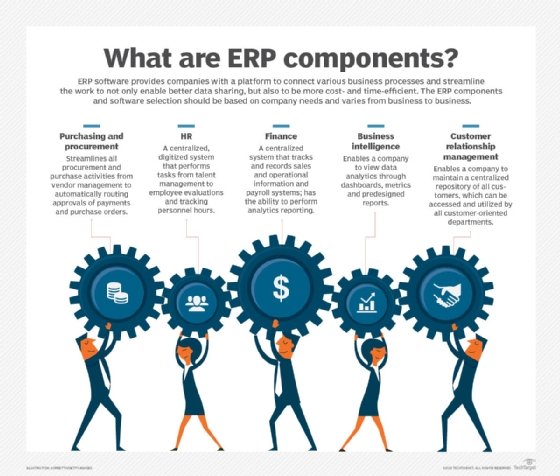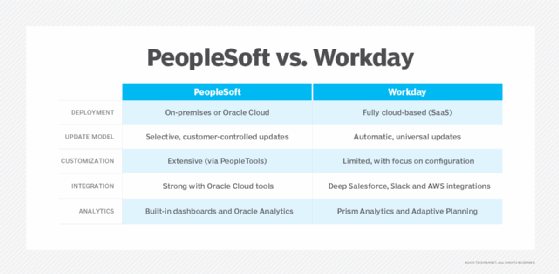What is PeopleSoft?
PeopleSoft is an enterprise resource planning (ERP) software suite owned by Oracle Corporation. Originally designed to support human resources (HR) and financial operations, PeopleSoft has since evolved to offer a wide range of industry-specific business applications, including solutions for healthcare, education, communications and manufacturing,
Acquired by Oracle in 2005, PeopleSoft now provides an integrated ERP platform that helps organizations with HR management, finance, supply chain, customer relationship management (CRM) and business analytics from a centralized system. While the platform historically focused on on-premises deployments, PeopleSoft now also supports cloud-compatible features, giving users hybrid flexibility.

Core PeopleSoft modules and use cases
Today, mid- to large-sized enterprises and government organizations use PeopleSoft to streamline operations, increase efficiency and ensure compliance. Key modules include the following:
- Human Capital Management (HCM).
- Financials and Supply Chain Management.
- Customer Relationship Management.
- Corporate Performance Management.
PeopleSoft also offers industry-specific capabilities for higher education, public sector, healthcare and more.
Top features of PeopleSoft
These modular capabilities are supported by powerful tools and flexible deployment options, which continue to evolve in response to user needs:
- PeopleSoft Selective Adoption, version 9.2 and above. This feature lets customers choose which updates to apply and when, while retaining existing customizations. Oracle delivers updated images roughly every 10 to 12 weeks, enabling customers to manage upgrades on their timeline.
- PeopleSoft Application Engine. Used for building and executing batch and online programs, Application Engine provides more efficient data processing compared to traditional Common Business-Oriented Language systems. Definitions are stored within the PeopleSoft database for greater flexibility and control.
PeopleSoft Human Capital Management
HCM supports HR tasks, such as payroll, benefits, promotions and employee data management. It also features a mobile-first design for anytime access, enabling users -- from employees to executives -- to interact with workforce data, approve tasks and perform analytics remotely.
Additionally, PeopleSoft continues to offer CRM tools, which are customizable for sales, service and marketing workflows.
Its business process management features enable the following:
- Workflow automation.
- Business rule configuration.
- Order and transaction management.
PeopleSoft has also embedded real-time analytics and dashboards across its applications, enabling data-driven decision-making without switching between tools.
PeopleSoft and Oracle Cloud integration
Oracle continues to support and enhance PeopleSoft HCM with AI-powered self-service features and better integration with Oracle Analytics Cloud. PeopleSoft now operates seamlessly with Oracle Cloud Infrastructure (OCI), thanks to Oracle's continued investment in hybrid cloud compatibility. Customers can do the following:
- Deploy PeopleSoft on OCI virtual machines.
- Migrate development and test environments to the cloud.
- Use PeopleSoft Cloud Manager to automate provisioning and maintenance.
- Integrate with Oracle Digital Assistant, Oracle Analytics and Oracle Autonomous Database.
Oracle has committed to supporting PeopleSoft through at least 2034, giving customers a long-term roadmap for hybrid deployment.
Workday vs. PeopleSoft
While Oracle Cloud integration has extended PeopleSoft's flexibility and longevity, it's still frequently compared to newer cloud-native platforms -- especially Workday, founded in 2005 by former PeopleSoft executives Dave Duffield and Aneel Bhusri. Workday is a leading cloud-native alternative to PeopleSoft, but the differences between the two platforms remain distinct.

Both Workday and PeopleSoft provide HR-related services, but their deployment options are significantly different. Workday is engineered for cloud deployment, meaning functionality upgrades are automatically released and every user is always on the latest version. Workday does not require on-premises hardware or infrastructure. Workday has also invested in collaboration tools such as Slack and platforms such as Salesforce, so users are easily able to combine their services.
PeopleSoft also provides cloud deployment, but users must purchase on-premises and private cloud implementations. PeopleSoft enables users to choose the updates they prefer and download and run them at their leisure, creating their own maintenance schedule. While this is convenient, it does require more supervision and intervention than Workday's updates, which are automatic.
While Workday appeals to organizations seeking simplicity and automatic upgrades, PeopleSoft remains ideal for customers who require customization, control and a long-term hybrid model. Additionally, PeopleSoft still commands loyalty from the public sector, universities and global enterprises.
PeopleSoft history
PeopleSoft was founded in 1987 by Dave Duffield and Ken Morris to launch their HR application. Their mission was to provide software to meet the changing demands of the business world.
In 1999, the company shifted its focus to the internet. In 2000, the company launched the web-based version of its software, PeopleSoft 8, as well as PeopleSoft e-center, its in-house application service provider. Its web-based applications are intended to integrate systems easily, so a company can connect customers, employees and suppliers more cost-effectively. An organization can streamline operations because the required information is readily accessible by a wide variety of people anytime and anywhere, including using mobile equipment, such as smartphones and tablets.
In 2003, PeopleSoft and rival company JD Edwards merged. Prior to merging with PeopleSoft, JD Edwards' product line, World and OneWorld, targeted midsize companies that were too small to fully benefit from PeopleSoft's applications. By merging with JD Edwards, PeopleSoft was able to properly provide for these companies, thus expanding its customer base. PeopleSoft later rebranded OneWorld as PeopleSoft Enterprise One.
In 2005, Oracle purchased PeopleSoft for $10.3 billion, adding CRM software to its product lineup. Shortly after acquiring PeopleSoft, Oracle laid off 5,000 of the company's employees. Oracle later rebranded the former JD Edwards product line. PeopleSoft Enterprise One became JD Edwards EnterpriseOne, and PeopleSoft World became JD Edwards World.
Today, PeopleSoft is a mature, highly customizable ERP system with a strong future backed by Oracle's continued investment and cloud capabilities.
Choosing the right ERP system involves various factors, such as company size and business goals. Here are common ERP use cases that can streamline your research. Also, explore the differences between ERP vs. accounting software and tips for a successful ERP upgrade project.






